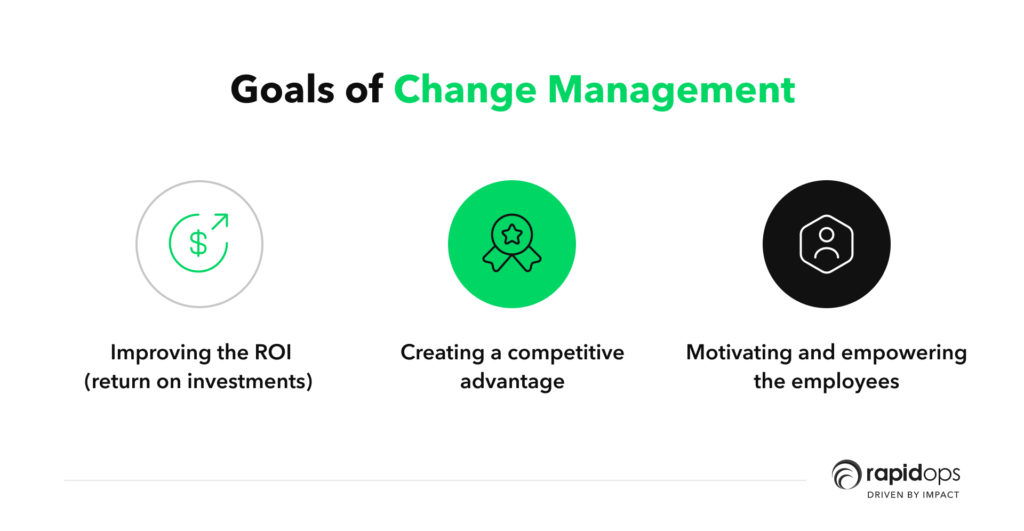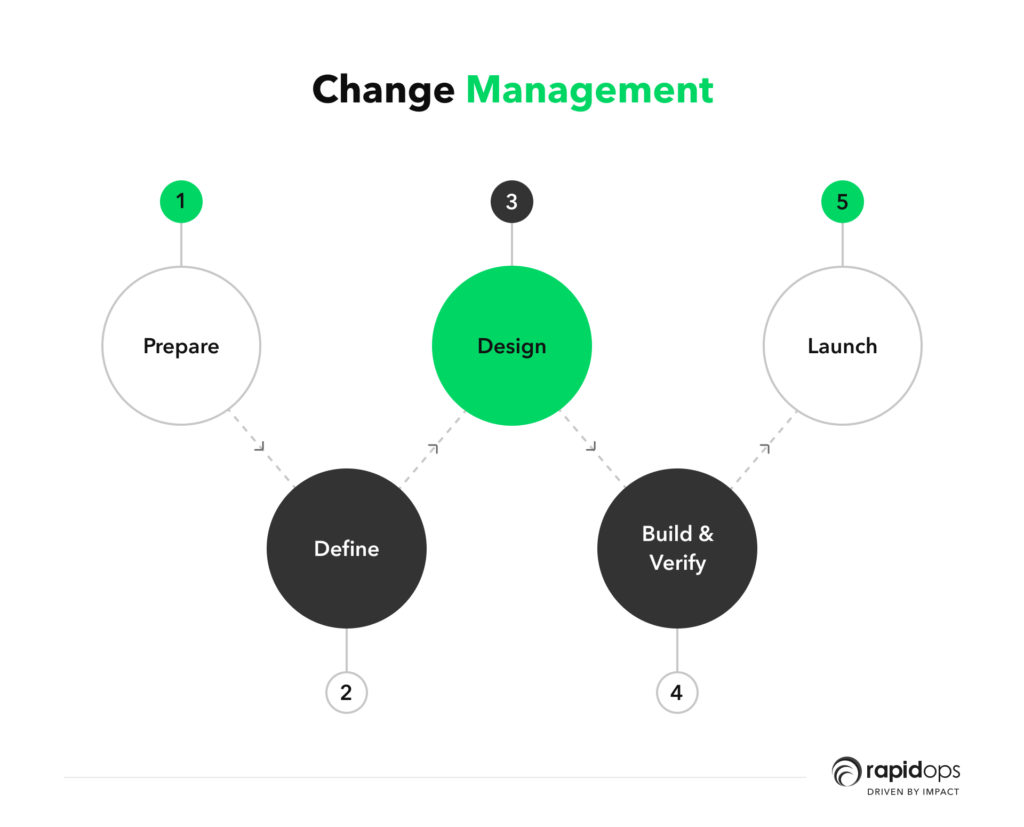Change management is one of the most crucial elements that ensure businesses can experience a successful digital transformation. Why? Well, imagine you have raised the proper budget, enlisted the right talent and technology, created an ultimate roadmap, and built a strategy, yet the digital transformation efforts failed.
Now, you are left asking yourself what you did wrong, where you missed it, and what did your strategy lacked? The modern market is increasingly pushing businesses of all shapes and sizes to opt for digitization, and the investments in business model digitization are visible.
To stay relevant in a rising market, businesses must merge offline and digital processes to stay consumer-focused, create interaction and be an agile organization.
Importance of change management in digital transformation
70% of Change Management efforts fail due to employee resistance and lack of management support. – According to McKinsey & Company
Changes led by digital transformation are different from changes that took place in the past. Why this statement? Well, the point is, disruptions take place after a particular time. It can vary from 5-to-15 years, depending on the organizational goal, age, and technology stack.
Businesses' digital transformation initiatives must combine high levels of scalability, interdependence, and dynamism, and all of these must create fundamental changes in multiple aspects of the organization.
If business leaders fail to take a segregated approach while applying digital transformation initiatives, they will experience a negative effect on the overall organizational resources.
Implying a wrong strategy or no change strategy will increase employee pushback.
This will create distrust amongst the workforce to use the chosen technology stack and delay the transformation project.
Communicating the intended change with a new operational process must happen in advance so that the workforce understands and adopts it quickly.
Goals of change management in digital transformation
In project management, it's easy for the person in charge to derive schedules, tangible objectives, and specific outcomes. Change management, on the other hand, follows reactive and uncertain paths.
Change management might vary from organization to organization. However, the strategies share these three primary goals:

1. Improving the ROI (return on investments)
The changes associated with digital transformation must be carried out mainly to enhance workforce efficiency and productivity.
So, select the tools and technologies that must assist the workforce to carry out their work at a better and faster rate.
Whether you are investing in a technology that helps streamline the inventory of your multiple stores or tools that help your workforce automate their mundane tasks, invest with ROI in mind.
2. Creating a competitive advantage
Before becoming a big name in your chosen market, your business was just an idea. Your company evolved by getting better at what it does, better than its competition.
Change management will assist you in changing your organizational structure by spotting growth opportunities through reduced costs, specialized offerings, innovation opportunities, and increased quality of product or service.
Gaining a competitive advantage in a constantly evolving market is vital for you in the long run, and change management helps you dictate this goal to your workforce.
It also enables you to make them understand and match their personal goals with organizational goals.
3. Motivating and empowering the employees
A recent survey by Couchbase uncovered a nearly 90 percent failure rate by CIOs and technology leaders who have tried to execute digital transformation initiatives.
Any change is intimidating and becomes a psychological factor as employees get used to a particular way of doing things and fear that the changes will lead to loss of income or lack of performance.
This is the primary reason behind the lack of support from employees in implementing change initiatives. Change management enables you to support the employees and empower them to support the change initiatives.
Via change management, you can assure the employees that their efforts will be recognized and get all the necessary support.
[data_analytics_essentials tag="INFORMATIONAL GUIDE" title="Discover the Keys to Digital Transformation Success with Our Comprehensive Guide." button_url="https://www.rapidops.com/resources/digital-transformation-guide/" image="https://www.rapidops.com/blog/wp-content/uploads/2023/05/transformation_guide_new_3@2x.png"]
The standard stages of digital change management

Let's explain this image in detail in the following statement.
1. Prepare
While you start off to make your digital transformation vision come true, keep change management at the center of it.
Apart from gathering funds, creating a business intelligence logic, and compiling the necessary resources also lay a solid foundation for driving the change.
Here are some of the critical change management activities that leaders must adhere to:
- Develop a digital transformation commission looking over the strategies and implementation of your business goals
- Identify every executive stakeholder and functional change agents as they will be critical to removing digital transformation roadblocks and creating advocacy
- Align your transformation goals with a center of excellence (COE) for efficiently managing your digital transformation efforts and governance structure
- Maintain your organizational change backlog for tracking and mitigating risks such as end-user adoption, employee resistance, legacy process retirement, etc.)
2. Define
In the define phase, you select the desired business outcomes, uncover the audience value via journey mapping, define various related requirements, design user experience, source the solution elements, and document the entire execution roadmap.
Apart from these crucial elements, here are some additional change management activities:
- Hold regular meetings with your COE stakeholders, functional leaders, and change agents and refine the vision and plan for steering the change in the right direction
- Conduct an organizational readiness assessment covering team structure and sponsorship, change governance, change adoption, progress measurement, and goal communication
- Host change management workshops, take feedback and uncover insights, strategies, and tactics required to drive the change across your transformation project
3. Design
You finalize the digital transformation blueprint in the design phase using wireframes, prototypes, proof of concepts, solution architecture charts, integration mapping, and data modeling.
These elements are critical to bringing your digital transformation vision to life for the broader set of stakeholders.
This phase takes in the inputs from the previous two phases and gets turned into a plan that assists the build and verifies phase. Some crucial activities to be included in this phase:
- Solidify the roles, workflows, and KPIs of the change team
- Resolve the business process impacts identified while in the prepare and define phase
- Define tangible KPIs to measure the progress
- Develop the new business strategy and plan
- Design the training flow
- Draft a communication plan
4. Build and Verify
Organizations must merge their project management tools, requirements, and use cases with a previously defined change management roadmap in the build and verify stage.
All the change management activities must get included in the same planning sessions, reviews, and stand-ups. Here are some of the change activities that must be included in this phase:
- Create a sequence for all the change management tasks and deliverables
- Import the sequence and assign the change management tasks into a shared project management environment
- Hold regular meetings with product/project teams and developers to align the change efforts for the deliverables
- Perform iterative development and quality assurance of the deliverables
- Hold feedback sessions to measure plan relevancy and resonance amongst the stakeholders
- Monitor and address all the change backlog
- Execute the pre-launch activities
5. Launch
Congratulations! The efforts have paid off, and it's time for the final launch. In the launch phase, you must drive the adoption of your chosen digital tool.
This is the most crucial phase of your entire change management journey.
Here you will understand whether your change management was adequately integrated into the digital transformation initiative, as most of the transformation work should be completed by the change team at this phase.
Every essential change management activity that must be included in the launch phase are:
- Execute at Launch and Post Launch adoption tactics
- Shift from project management to program management governance model
- Listen, measure, and share feedback with all the stakeholders
- Monitor and address the change backlog
Concluding thoughts: Change management is as dynamic as your organization's core functionality
During the recent Covid-19 pandemic, companies that had already transformed digitally smoothly sailed past the roadblocks.
Digital transformation is challenging, and it frequently fails. But that happens in the absence of change management. The core ingredients of every successful digital transformation initiative include:
- Strategy — Where you align vision, customer experience, business processes, and technology
- User-centered design — Focusing on becoming mobile-first and taking the help of a hyper-personalized UX approach
- Agile delivery — With proper frequency and adaptability
- Integration — Choosing environments and products that harmonize with your chosen software, platforms, and technology stack
- Data — Analytics and insights help you build an informative and constant feedback loop
- Execution — A progressive product design mindset that focuses on minimally viable products and works with the fail-fast mentality
We hope this article allowed you to understand the scope of having a sound change management strategy in place to enjoy digital transformation success.
The importance of having an advanced technology solutions company as your digital project partner helps you achieve and maintain a competitive advantage in your industry.
Rapidops has 13+ years of experience in building digital solutions for startups and established industries by leveraging cutting-edge and disruptive tools and technologies.
We have helped businesses increase productivity and decrease irrelevant costs to enjoy higher operating capacity.

Saptarshi Das
Content Editor
9+ years of expertise in content marketing, SEO, and SERP research. Creates informative, engaging content to achieve marketing goals. Empathetic approach and deep understanding of target audience needs. Expert in SEO optimization for maximum visibility. Your ideal content marketing strategist.

Let’s build the next big thing!
Share your ideas and vision with us to explore your digital opportunities
Similar Stories
- Transformation
- undefined Mins
- March 2020

- Transformation
- undefined Mins
- February 2022


Receive articles like this in your mailbox
Sign up to get weekly insights & inspiration in your inbox.

